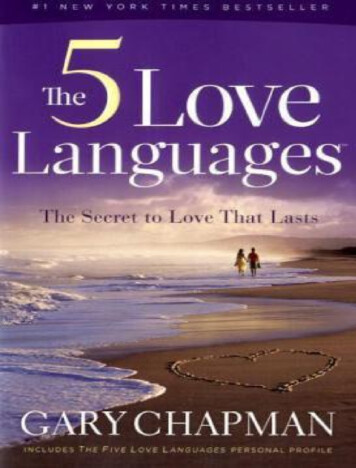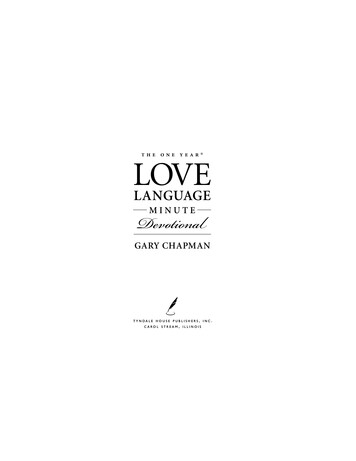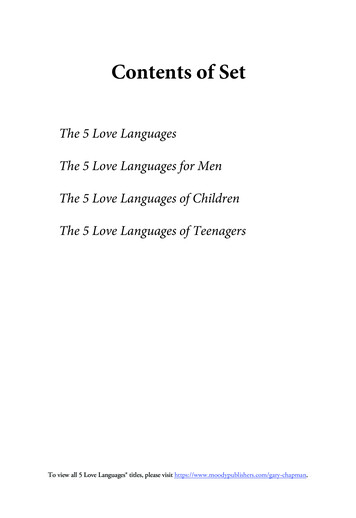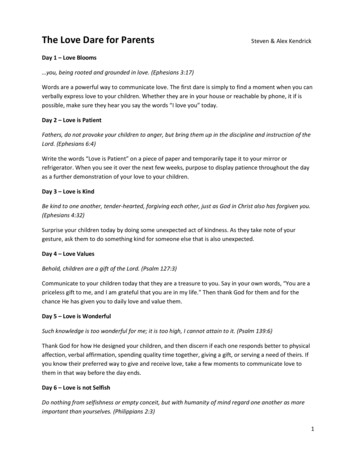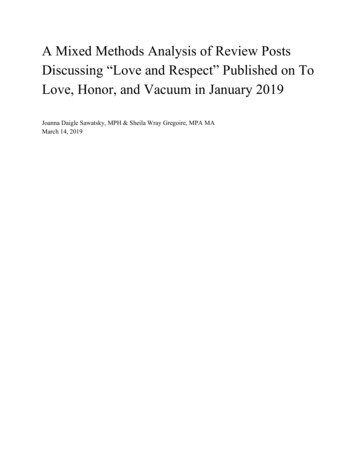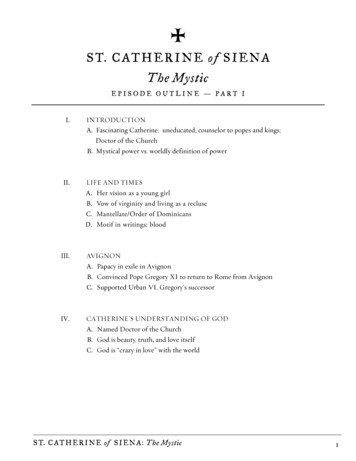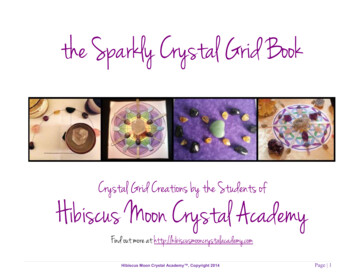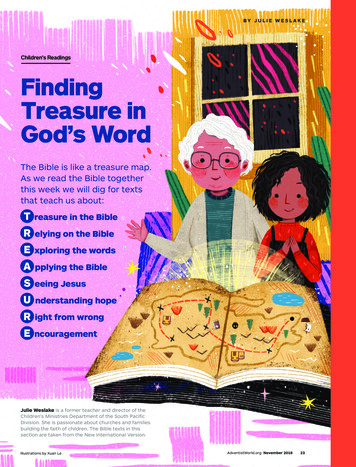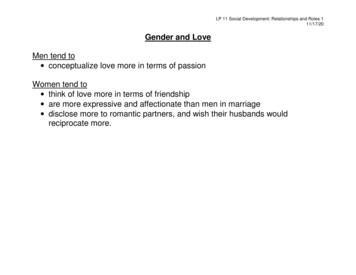
Transcription
LP 11 Social Development: Relationships and Roles 111/17/20Gender and LoveMen tend to conceptualize love more in terms of passionWomen tend to think of love more in terms of friendship are more expressive and affectionate than men in marriage disclose more to romantic partners, and wish their husbands wouldreciprocate more.
LP 11 Social Development: Relationships and Roles 211/17/20The Triangular Theory Perspective of HappinessSternberg’s triangular theory of love (also referred to as the triarchy of love) hasthree components: Passion (sexual arousal) Intimacy (feelings of closeness), Commitment (a lifelong bond)
LP 11 Social Development: Relationships and Roles 311/17/20The Triangular Theory Perspective of HappinessConsummate love tends to be fragile because the physiological arousal fromyour partner can fluctuate over time. This is why, I suspect that you and yourpartner should find engage in activities that you both enjoy and are stimulating.
LP 11 Social Development: Relationships and Roles 411/17/20The Triangular Theory Perspective of HappinessWhat components of love do the following individuals have?
LP 11 Social Development: Relationships and Roles 511/17/20The Five Languages of LoveDr. Chapman identified five emotional love languages—five ways that peoplespeak and understand emotional love.The way you and your partner may communicate love may be different from oneanother. In order to effectively communicate, you will need to recognize yourown language of love as well as your partner’s (or future partner’s). Becauselove is something you do for someone else, it is important that you learn the lovelanguage of your partner.Dr. Chapman’s Five Languages of Love Words of Affirmation Acts of Service Receiving Gifts Quality Time Physical Touch
LP 11 Social Development: Relationships and Roles 611/17/20Languages of LoveWords of AffirmationWords of affirmation, positive and supportive statements toward your partnerare important for building and maintaining relationships.Some people need verbal appreciation and encouragement in order to feelloved. Complement your partner. It may be as simple as “You look great in that suit,” or “You are the best yard guy we have ever had”, or “I know you will finish your degree”.Acts of ServiceSometimes simple chores or tasks around the house can communicate toanother person love. These tasks are done out of kindness, not out ofobligation.
LP 11 Social Development: Relationships and Roles 711/17/20Languages of LoveReceiving GiftsIt is one thing to remember birthdays and anniversaries. It’s quite more tolearn how to give “little gifts” of thoughtfulness through the week.It can show that you are thinking about the person and if you know theperson, demonstrate your knowledge of them (certainly, bad gifts can workagainst you).Quality TimeQuality time is more than being in the same room. It’s about focusing allyour energy on your partner. It is interacting and doing thing together andpaying attention to their needs. It’s turning off the TV and giving each otherquality time—quality listening time and doing something together.Physical TouchMany feel the most loved when they receive physical contact from theirpartner—a hand on the shoulder, a hug, a kiss, holding hands as well assexual touching.
LP 11 Social Development: Relationships and Roles 811/17/20Languages of Love
LP 11 Social Development: Relationships and Roles 911/17/20MarriageWhen asked about the reasons for their marriage to last, many reported having apositive attitude toward their partner.Spouse are seen as their best friend and they like him or her as a person (seeunconditional positive regard). They are aware they have their faults, but theirlikeable qualities outweigh their shortcomings (page 268). Marriage takes workand both partners need to work at solving their problems.It is important for you to know what your life goals are, what your values are andwhat your self-concept is AND live your life in a way that moves you in thatdirection. You need to be honest with yourself about your goals, values and selfconcept and when you are deviating off from it.Trust and goodwill are important for self-disclosure and deepening relationships.If you aren’t honest with yourself, you are going to hesitate in disclosinginformation.
LP 11 Social Development: Relationships and Roles 1011/17/20Successful Marriages Start Off on the Right FootConflict resolution is important for successful marriages, but there arecharacteristics that successful marriages have already in addition to goodcommunication and conflict resolution skills. Successful relations can be predicted from how couples fight, and how theyinteract when they are not fighting (see DARVO: denial, attack, reversevictim and offender). Successful marriages are less likely to have arguments that can’t beresolved (unsuccessful marriages have arguments that can’t be resolvedand too much time is spent trying to resolve the unresolvable).
LP 11 Social Development: Relationships and Roles 1111/17/20Why Marriages Succeed or FailJohn and Jane Gottman observed couples’ interactions, quarrels, and attemptsat resolution. Within five minutes of an argument, they can accurately determinewhether a couple’s relationship will last.When couples were observed, a partner would try to make a connection with theother (in the article, he called it a bid). The following was copied from the article,Masters of Love (Masters vs. Disasters)For example, say that the husband is a bird enthusiast and notices agoldfinch fly across the yard. He might say to his wife, “Look at that beautifulbird outside!” He’s not just commenting on the bird here: he’s requesting aresponse from his wife—a sign of interest or support—hoping they’llconnect, however momentarily, over the bird.The wife now has a choice. She can respond by either “turning toward” or“turning away” from her husband, as Gottman puts it. Though the bird-bidmight seem minor and silly, it can actually reveal a lot about the health of therelationship. The husband thought the bird was important enough to bring itup in conversation and the question is whether his wife recognizes andrespects that. People who turned toward their partners in the studyresponded by engaging the bidder, showing interest and support in the bid.
LP 11 Social Development: Relationships and Roles 1211/17/20Those who didn’t—those who turned away—would not respond or respondminimally and continue doing whatever they were doing, like watching TV orreading the paper. Sometimes they would respond with overt hostility, sayingsomething like, “Stop interrupting me, I’m reading.”These bidding interactions had profound effects on marital well-being.Couples who had divorced after a six-year follow up had “turn-toward bids”33 percent of the time. Only three in ten of their bids for emotionalconnection were met with intimacy.The couples who were still together after six years had “turn-toward bids” 87percent of the time. Nine times out often, they were meeting their partner’semotional needs.By observing these types of interactions, Gottman can predict with up to 94percent certainty whether couples—straight or gay, rich or poor, childless ornot—will be broken up, together and unhappy, or together and happy severalyears later. Much of it comes down to the spirit couples bring to the relationship.Do they bring kindness and generosity; or contempt, criticism, and hostility?
LP 11 Social Development: Relationships and Roles 1311/17/20“There’s a habit of mind that the masters have,” Gottman explained in an interview, “which is this: theyare scanning social environment for things they can appreciate and say thank you for. They are buildingthis culture of respect and appreciation very purposefully. Disasters are scanning the social environmentfor partners’ mistakes.”“It’s not just scanning environment,” chimed in Julie Gottman. “It’s scanning the partner for what thepartner is doing right or scanning him for what he’s doing wrong and criticizing versus respecting himand expressing appreciation.”
LP 11 Social Development: Relationships and Roles 1411/17/20Masters Of Love: Contempt and KindnessContempt, they have found, is the number one factor that tears couples apart.People who are focused on criticizing their partners miss a whopping 50 percentof positive things their partners are doing and they see negativity when it’s notthere. People who give their partner the cold shoulder—deliberately ignoring thepartner or responding minimally—damage the relationship by making theirpartner feel worthless and invisible, as if they’re not there, not valued. And peoplewho treat their partners with contempt and criticize them not only kill the love in the relationship, but theyalso kill their partner's ability to fight off viruses and cancers. Being mean is the death knell ofrelationships.Kindness, on the other hand, glues couples together. Research independentfrom theirs has shown that kindness (along with emotional stability) is the mostimportant predictor of satisfaction and stability in a marriage. Kindness makeseach partner feel cared for, understood, and validated—feel loved. “My bounty is asboundless as the sea,” says Shakespeare’s Juliet. “My love as deep; the more I give to thee, / The moreI have, for both are infinite.” That’s how kindness works too: there’s a great deal of evidenceshowing the more someone receives or witnesses kindness, the more they willbe kind themselves, which leads to upward spirals of love and generosity in arelationship.
LP 11 Social Development: Relationships and Roles 1511/17/20Masters Of Love: KindnessThere are two ways to think about kindness. You can think about it as a fixed trait: either you have it or you don’t. Or you could think of kindness as a muscle. In some people, that muscle isnaturally stronger than in others, but it can grow stronger in everyone withexercise.Masters tend to think about kindness as a muscle. They know that they have toexercise it to keep it in shape. They know, in other words, that a good relationshiprequires sustained hard work.
LP 11 Social Development: Relationships and Roles 1611/17/20Masters of Love: Disasters and Masters in an ArgumentThe hardest time to practice kindness is, of course, during a fight—but this is alsothe most important time to be kind.Letting contempt and aggression spiral out of control during a conflict can inflictirrevocable damage on a relationship. “Kindness doesn’t mean that we don’texpress our anger,” Julie Gottman explained, “but the kindness informs how wechoose to express the anger. You can throw spears at your partner. Or you canexplain why you’re hurt and angry, and that’s the kinder path.”John Gottman elaborated on those spears: “Disasters will say things differently in a fight. Disasters will sayo ‘You’re late.o What’s wrong with you?o You’re just like your mom.’ Masters will sayo ‘I feel bad for picking on you about your lateness, and I know it’s notyour fault, but it’s really annoying that you’re late again.’”
LP 11 Social Development: Relationships and Roles 1711/17/20Masters of Love: PhysiologyThe disasters looked calm during the interviews, but their physiology, measuredby the electrodes, told a different story. Their heart rates were quick, their sweat glands were active, and their blood flow was fast.Following thousands of couples longitudinally, Gottman found that the morephysiologically active the couples were in the lab, the quicker their relationshipsdeteriorated over time.The masters, by contrast, showed low physiological arousal. They felt calm and connected together, which translated into warm andaffectionate behavior, even when they fought.It’s not that the masters had, by default, a better physiological make-up than thedisasters; it’s that masters had created a climate of trust and intimacy that madeboth of them more emotionally and thus physically comfortable.
LP 11 Social Development: Relationships and Roles 1811/17/20Masters of Love: PhysiologyBut what does physiology have to do with anything?The problem was that the disasters showed all the signs of arousal—of being infight-or-flight mode—in their relationships. Having a conversation sitting next totheir spouse was, to their bodies, like facing off with a saber-toothed tiger. Evenwhen they were talking about pleasant or mundane facets of their relationships,they were prepared to attack and be attacked. This sent their heart rates soaringand made them more aggressive toward each other.For example, each member of a couple could be talking about how their dayshad gone, and a highly aroused husband might say to his wife, “Why don’t youstart talking about your day. It won’t take you very long.”
LP 11 Social Development: Relationships and Roles 1911/17/20The 5-to-1 ratioWhether you face conflict or avoid it; communication style for maintaining ahealthy relationship is more important than how well you solve problems and howcompatible they are (socially, financially, or sexually).Positive long-term relationships maintain about a 5-to-1 ratio of positiveinteractions to negative interactions in their relationship compared to those thatare divorced.
LP 11 Social Development: Relationships and Roles 2011/17/20Seven Principles that can Facilitate a Relationship Know your partner’s dreams, hopes and interests. Nurture your fondness and admirationo Express caring and respect. You use positive self-statements and avoidnegative self-statements for yourself and your partner (this doesn’tmean you should ignore problems). Couples should have a 5-to-1 ratioof positive to negative comments and interaction. Turn toward each other instead of awayo Express your love every day—not just once or every now and then.Engage in activities together Let your partner influence you Solve your solvable problems Overcome gridlock Create shared meaning—share rituals, traditions and common activitiesCouples that spent five hours or more per week on their relationship practicingthese seven principles had continual improvements in their marriages. Timespent on these both before and after courtship lead to healthier relationships.
LP 11 Social Development: Relationships and Roles 2111/17/20Answer these questions as honestly as you can. The more “yes” boxes youcheck, the stronger your relationship is likely to be.Yes No1. Do you have realistic expectations about your relationship—realizingthat passion and intimacy don’t magically last forever?2. Do you engage in activities that your partner feels as passionate aboutas you do?3. Does sacrificing your own needs to make your partner happy give youpleasure, and are you devoted to your mate’s emotional growth?4. Are you affectionate and positive with your partner?5. Do you solve differences of opinion in a constructive way—and not getpersonal when you fight?6. Do you give your partner space to make his or her own decisions andchoices?7. Do you listen to your lover’s complaints without getting defensive?
LP 11 Social Development: Relationships and Roles 2211/17/20Coping with the Transition to Parenthood Don’t expect your romantic feelings about each other to stay the same—they won’t. Try to agree on who is going to do what around the house, but understand that you may fall intomore traditional roles. Work on your communication skills before the baby arrives.For Mothers Understand that you won’t and can’t be the perfect mother—in fact, sometimes you will be utterlyterrible—and accept yourself for being human! Don’t buy into the fantasy of producing a perfect child. Children cannot be micromanaged intobeing perfect. Focus on enjoying and loving your child as he or she is (see also Chapter 7 ). Don’t listen to people who say that working full time automatically means that you can’t be aninvolved mother. Remember the findings discussed in this section.For Fathers Understand that your role is full of contradictions—and that there is no “perfect” way to be a dad. Be aware of your attitudes toward hands-on child-care, and clearly communicate these feelings toyour partner. On the other hand, be a sensitive, loving dad! A strong message from the research is that if yourpartner feels you are a great father, your relationship is more likely to thrive after the baby arrives.
Why Marriages Succeed or Fail John and Jane Gottman observed couples’ interactions, quarrels, and attempts at resolution. Within five minutes of an argument, they can accurately determine whether a couple’s relationship will last. When couples were ob
